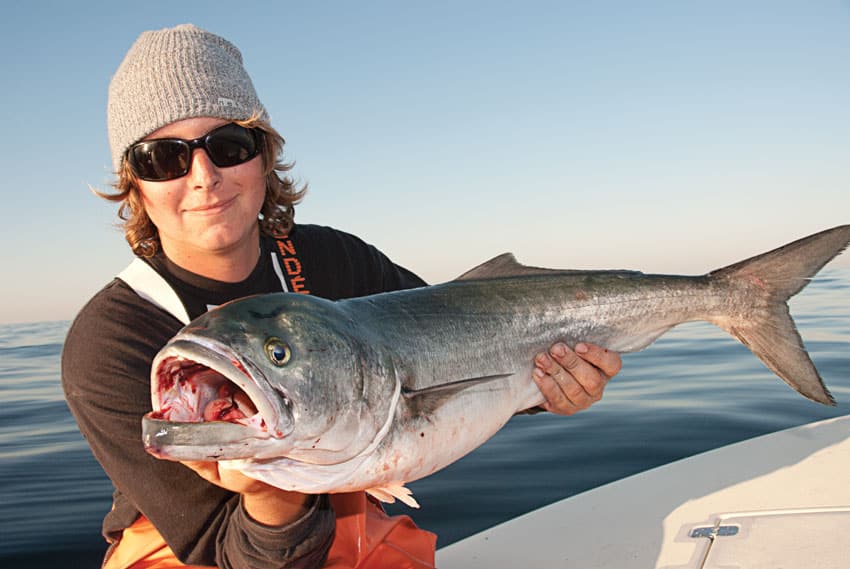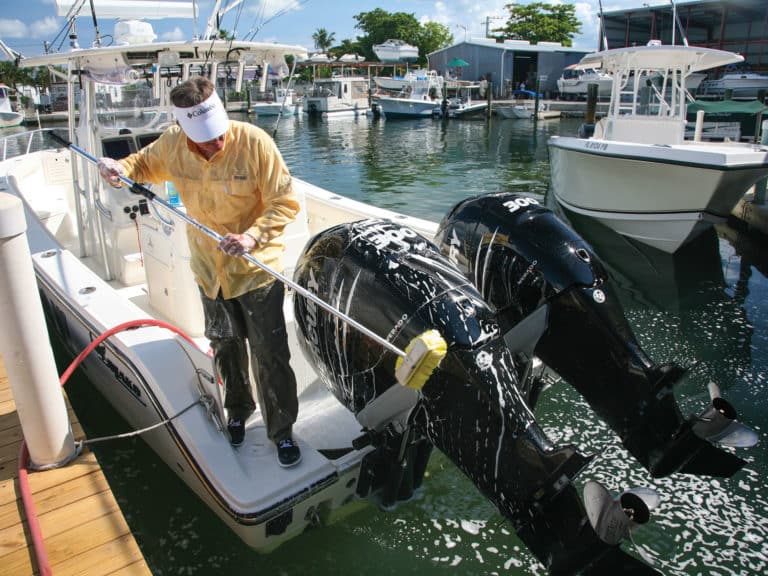
Follow the Bait
There was already a crowd of buggies at Cape Point on the Outer Banks of North Carolina when the first wave of bluefish hit the beach. News of the run had traveled fast, and the stream of vehicles that descended on the beach for bluefish fishing made the scene look more like the Normandy invasion. At the point, surf fishermen parked 35 to 40 deep – perhaps 1,000 to 1,200 buggies in all. The bluefish averaged ten to 15 pounds. On the south side of the point, where the heaviest concentrations of fish were blitzing, the water flowed hard from left to right. After hooking fish, skilled anglers followed them down the beach while hooked-up. Excited newcomers stood confused, letting fish run down the beach, lines wrapping around the feet of other anglers. In the chaos, lines crossed and tangled, anglers cast over other anglers’ lines as they fought fish and many lures were snapped off when cast. Bait fishermen trying to fish the bottom were overrun by the mob of anglers casting lures. There must have been 100 lures lost and as many fish broken off, yet no one got angry – in some places there would have been fistfights, but the manners of these anglers were exceptional – everyone had fun.
Bluefish create this kind of excitement because from the time they are small “snappers” until they die, they feed like piranha. A big blue is called a chopper, and its biting power is notorious – easily cutting a three-pound menhaden in half. Their stubborn fighting ability caused A. J. McClane to declare: “If bluefish grew to the size of the bluefin tuna, nothing could stand before them in the oceans of the world.” Because bluefish can be such aggressive feeders, topwater splashing lures are effective baits during a bluefish blitz, and there is nothing more exciting than watching bluefish attack a plug.
Skipping the Chop
When bluefish roam or hold in big rips, teardrop-shaped lures that bounce along the surface are my top pick. Nicknamed rangers, bounders or rabbit plugs, these lures are designed for casting long distances and work well in places with strong rips like Great Point on Nantucket or Cape Point at Hatteras where long casts are often necessary to reach the fish. Ideal water conditions include short, choppy waves created either by the rip itself, a wind chop or a combination of both. Make the lure skip along the surface, causing as much commotion as possible. When casting across the flow, hold the rod tip high and keep pumping the tip while reeling quickly in an effort to make the lure jump through the chop and bounce off the tops of the waves. When bringing the lure straight up the flow, use a slower retrieve and more rod-tip movement. A slow to medium-speed retrieve is also worth a try as the tide slackens, fluttering the lure along the surface.
This style of lure is not buoyant. To bring it to the surface quickly after casting, close the bail just before the lure hits the water and start reeling. If the waves are too high, these plugs might dig in. In this case use the same techniques as you would with a big pencil popper or splashing popper.
Popping the Calm
When bluefish are feeding on sand eels, silversides, bay anchovies or other small baitfish, pencil poppers are a good lure choice. When fishing sheltered bays and sounds, or when the ocean beaches are calm, look for bluefish to roam, hunting for food. A pencil popper is really a surface slider that makes a subtle splash. It’s a great tool for arousing non-feeding fish. Small to mid-size pencil poppers worked slowly along the surface are one of the best plugs to use in calm water. Work the plug by changing both the speed of the retrieve and the action of the rod. A faster retrieve with short rod-tip movements gives the plug a slight wiggling action as it slides through the water making a bubbling noise.
Using a slower retrieve with aggressive rod-tip movement gives the lure a noisy splashing action that excites fish and will draw them from a distance. If you need to cover large sections of water, a fast retrieve works better. In the spring, bluefish will sometimes act uncharacteristically – swimming around in circles or finning along the surface. When the fish engage in this activity, perhaps related to spawning, they often will not bite. A slow-moving pencil popper can motivate bluefish to strike.
Splashing the Surf
Surface-splashing poppers are the mainstay for shore anglers. They work in most water types, can be cast long distances, are ideal when fighting the wind and entice fish into striking. Because they make noise, move plenty of water and stand out in a turbulent chop – even a small popper can look large to bluefish. In rough water or in rolling surf, use a faster action to make as much commotion as possible. When fishing the plug through heavy white water, use a slower retrieve with loud splashes. As a wave rolls off the beach, cast and work the outer edge of that flow using hard pulls with the rod tip while letting the plug move with the flow. At times you will use only rod action, not retrieving, to make the plug pop. Fish the outer bar using a steady retrieve with a continuous splashing action. Watch the waves. After a wave breaks, cast into the bubbling water, fishing the top of the bar and the dropoff just inside the bar. A slow retrieve with aggressive rod-tip snaps makes the lure swim with a side-to-side action, dancing violently, yet moving very slowly through the water. This technique works with some splashing poppers and is ideal for pencil poppers. However, moving the rod tip with this much action while reeling slowly creates slack line, and you must keep tension on the line to prevent tangles. To eliminate slack line, hold the rod almost straight up and move the hand that grips the rod up to a position about 18 inches above the reel. Pinch the line between the thumb and forefinger as you reel – this will pack the line tightly onto the reel, eliminating casting bird’s nests.
Running of the Blues
Bluefish winter in Florida before making runs up virtually the entire East Coast. Down South, look for runs to occur off the beach in December and continue along shore into March before the fish migrate north. They appear along North Carolina and Virginia in late March and April. Racer blues – skinny fish with big heads – migrate up the coast while other schools of fish leave the main group, staying through the summer in locations such as Chesapeake Bay and along the shorelines from Virginia to Massachusetts. In southern New England, fishing starts in late May and early June and can last all summer. The Northeast fall run starts in mid-September continuing into late October. The peak run occurs off the Outer Banks of Hatteras in North Carolina around Thanksgiving, and by mid- to late December bluefish begin to arrive back in Florida. The runs of big bluefish that occurred in the ’70s to mid ’80s at Race Point on Cape Cod and Great Point on Nantucket have diminished, likely due to the declining runs of menhaden. There is, however, still good fishing, and large numbers of smaller fish in recent years offer some hope for the future. From Montauk Point on Long Island south to North Carolina there are good numbers of fish, and the Outer Banks boasts probably the best bluefishing anywhere.









